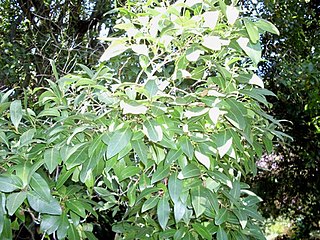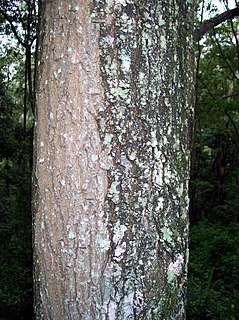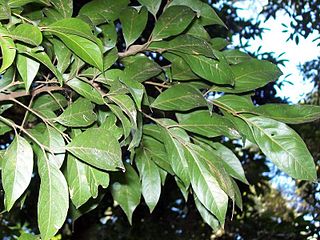
Endiandra is a genus of approximately 100 species of plants, mainly trees, in the laurel family Lauraceae. They are commonly called "walnut" despite not being related to the Northern Hemisphere walnuts which are in the family Juglandaceae.

Endiandra sieberi, known as the corkwood is a rainforest tree growing in eastern Australia.

Cryptocarya obovata is a large laurel growing on basaltic and fertile alluvial soils in eastern Australian rainforests. It is found from Wyong in New South Wales to Gympie in the state of Queensland. Extinct in the Illawarra region, allegedly seen in the Illawarra in 1818 by Allan Cunningham. The species was included in the Prodromus Florae Novae Hollandiae et Insulae Van Diemen, 402 (1810)

Beilschmiedia elliptica, known as the grey walnut is a rainforest laurel growing in eastern Australia. The range of natural distribution is from Forster, New South Wales to Fraser Island in south eastern Queensland. Beilschmiedia elliptica grows in warm temperate and sub tropical rainforests. Not a rare species, but seldom identified in the rainforest.

Streblus brunonianus, known as the whalebone tree, is a small tree in the fig family. Commonly seen in a variety different types of rainforest, particularly by streams.

Endiandra pubens is a rainforest tree growing in eastern Australia. The habitat is subtropical rainforest growing near streams in valleys. The range of natural distribution is from the Bellinger River, New South Wales to Bulburin National Park, south west of Gladstone, Queensland.

Endiandra discolor is an Australian tree, growing from near Gosford, New South Wales to Tully, Queensland in the tropics. Common names include rose walnut and domatia tree.

Endiandra virens is an Australian tree in the laurel family. Growing from Boorganna Nature Reserve north west of Taree, New South Wales to Kin Kin in Southern Queensland. Common names include White Apple, Plumwood, and New South Wales Walnut.

Arytera divaricata, known as the gap axe, coogara, coogera or rose tamarind is a forest tree of eastern Australia. An attractive plant with glossy pale and limp new leaves. It grows in fairly dry situations, often in littoral rainforests and monsoon forest.

Dysoxylum mollissimum subsp. molle, the red bean or Miva mahogany, is a rainforest tree in the family Meliaceae. It occurs in tropical, sub-tropical and littoral rainforests in eastern Australia, as far southwards as north-eastern New South Wales. Also occurs in Malesia and the south-western Pacific Islands. In Australia it is distributed from the Bellinger River in New South Wales in the south, to the wet tropics of north-eastern Queensland. The specific epithet mollissimum is from the Latin, meaning "very soft", describing the soft hairy leaflets. A signposted red bean tree may be seen near the car park of Victoria Park Nature Reserve in north-eastern New South Wales.

Elattostachys nervosa, known as the green tamarind or beetroot tree is a common rainforest tree of eastern Australia. Found in all types of rainforest, growing from Paterson, New South Wales in the south to Gympie in south east Queensland. The name Elattostachys refers to "little spikes", a flower feature of other plants in this genus. Nervosa refers to the prominent leaf venation. Beetroot Tree refers to the beetroot red leaves of the new growth.

Cryptocarya bidwillii, the yellow laurel, is a small to medium-sized tree in the laurel family. Occurring in Australian rainforests from Nymboida in the state of New South Wales to Townsville in tropical Queensland. Often found in the dryer ridges in dry rainforest or in viney scrubs.

Bridelia exaltata, known as the brush ironbark or scrub ironbark, is a tree of eastern Australia. It occurs in and on the margins of the drier rainforests. Also occurring by streams, often in association with the Black Bean, up to an elevation of 600 metres above sea level. It occurs from Seal Rocks, New South Wales to Maryborough, Queensland.

Sarcopteryx stipata, known as the steelwood, is a rainforest tree of eastern Australia occurring from the Bulga Plateau and Comboyne Plateau north west of Taree, New South Wales as far north as Fraser Island off the coast of south eastern Queensland. It grows in sub tropical rainforest but sometimes occurs in warm temperate rainforests on poorer soils. It is a member of the soap berry family. The generic name Sarcopteryx translates to "fleshy wing", as the fruit can be wing shaped. Stipata means "surrounded". The common name steelwood refers to the very tough, hard and heavy timber.

Endiandra hayesii is an Australian rainforest tree. Despite the common name of rusty rose walnut, this tree is unrelated to northern hemisphere walnuts, and is a laurel. The former habitat is lowland sub tropical rainforest, most of which has been cleared. However some trees persist in cool sheltered gullies as far south as the Richmond River, New South Wales to just over the border at Burleigh Heads in Queensland. The rusty rose walnut is considered rare, with a ROTAP rating of 3RC-. It is named after H.C. Hayes, who collected this species at Minyon Falls.

Endiandra introrsa is a rare rainforest tree growing in eastern Australia. Listed with a Rare or Threatened Australian Plants (ROTAP) rating of 3RCa. Its habitat is warm temperate rainforest on the poorer rainforest soils, mostly over 300 metres in altitude, and its range of natural distribution is from near Dorrigo to various sites in the state of Queensland.

Endiandra muelleri subsp. bracteata, is a rare rainforest tree growing in eastern Australia. Listed as endangered by extinction. It is a subspecies of the tree known as green-leaved rose walnut, or Mueller's walnut, Endiandra muelleri. It occurs from Maclean, New South Wales to Mackay, Queensland, usually in sub tropical rainforest at the lower altitudes.

Alangium villosum subsp. polyosmoides is a rainforest tree of eastern Australia. It occurs on a variety of different soils and rainforests, relatively close to the coast. Found from Minmi near Newcastle to as far north as the McIlwraith Range in far north eastern Australia. It may be seen as a common understorey plant at Wingham Brush Nature Reserve.

Planchonella queenslandica, the blush condoo, is a large rainforest tree of the family Sapotaceae native to eastern Australia. It's found in sea side rainforest as well as the drier inland rainforests. From as far south as the Richmond River, New South Wales to Coen in tropical Queensland, and as far west as Melville Island, Northern Territory.

Litsea australis, the brown bollygum or brown bollywood is a species of rainforest tree in the laurel family, found in eastern Australia. The specific epithet australis means "southern". As this southern population was considered to be Litsea leefeana, until reclassified by the rainforest botanist Bernie Hyland in 1989. This species is found in a variety of different rainforest types, but often seen growing near the sea. Distributed from Forster, New South Wales in the south to Fraser Island in Queensland.



















